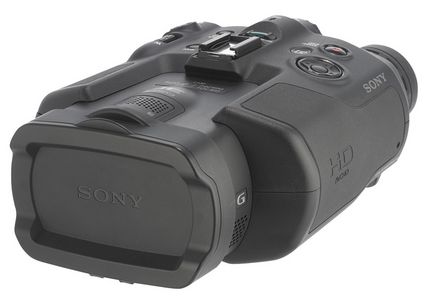Sony DEV-5 3D Recording Binoculars review
 | About Sony DEV-5The Sony DEV-5 uses two 1/4in Exmor R CMOS sensors to create a set of 3D recording binoculars that let you photograph or video outdoors in environments not suited to a camcorder or camera. The DEV-5 is of obvious interest to those with an interest in wildlife video and photography, but would also suit those wanting to record and enjoy sports events or other outdoor occasions.
We used the DEV-5 in a torrential downpour and it suffered no ill effect, although we did have to wipe the lenses every so often. The lenses are partially protected by a plastic surround, but this only protects it from rain and snow so much. A plastic lens cover protects the lenses when the DEV-5’s not in use, but it isn’t detachable. This means you can’t lose the lens cover, but it also means it gets in the way occasionally. Unsurprisingly, given the amount of technology crammed into it, the DEV-5 is not small, measuring 88x155x219mm (HxWxD). It also weighs 1.2Kg, which is more than twice the weight of the Sony TD20VE 3D camcorder. Surprisingly, the DEV-5 only feels heavy when it’s hanging around your neck, but this is probably due to the unit being very well balanced in use. It felt so heavy when strung around our neck that we held it up to give our spine some relief, but it felt light when held up to our eyes. We expected it to be front heavy and to have to compensate for this, but it wasn’t. You must set up the DEV-5 for your eyes before use, but the DEV-5’s controls and the viewfinder’s menu make this easy. The DEV-5 uses a 3D electronic viewfinder, although it can operate in 2D if you prefer (there’s a button on the DEV-5’s top panel). To set it up for your eyes, you must physically adjust the position of the diopters (the eyepieces) using a wheel located in between and above them. Once adjusted, you must also complete a simple visual alignment test through the viewfinder. Each diopter also has a ring that lets you adjust the viewfinder’s focus to suit your eyes. We had no problem adjusting it to suit our longsighted eyes. |
Understandably, the DEV-5 doesn’t have a touchscreen monitor. Instead, you must use the viewfinder to view and alter all settings, which is no bad thing because it’s excellent. The menu is the same as that found on Sony’s other high-end camcorders such as the CX730E and the TD20VE. Everything appears huge and is easily visible. Sure, you can see some jagged edges on various icons if you look closely enough, but the menu is of such a high resolution that you won’t notice the jaggies in normal use.
The directional menu buttons on the DEV-5’s top panel make navigating the menu simple and natural, with your digits naturally falling upon them. The top panel also has buttons to switch between photo and video modes, and to switch the viewfinder between 2D and 3D.
Conveniently, the DEV-5 also has a push-button wheel in between and just below the diotpers to which you can assign a specific function such as focus, 3D depth and shutter speed. You can easily select the setting you want to control at any time by pushing a button at the centre of the wheel and choosing a setting from the drop-down menu. The wheel is quick and simple to use and configure.
Perhaps the most obvious top-panel control is the chunky zoom lever, which lets you zoom in 10x when set to optical zoom only and 20x when set to digital in 2D mode. You’re restricted to 5.4x when shooting in 3D. The zoom lever lets you execute an incredibly smooth or very quick zoom, giving you complete control.
You can shoot 1080/50p Full HD video in 2D or 1080/50i Full HD video in 3D mode. We were impressed by the colour reproduction of the DEV-5, and the high level of detail captured, but it was prone to very noticeable noise when shooting indoors or in low light. Outdoor footage looked great, but not quite as crisp or natural as that captured by the Sony CX730E. Sadly, the DEV-5 also displayed a tremendous amount of noise outside of the optical zoom range. The low optical zoom range of the DEV-5 is disappointing for a set of binoculars, and you often have no choice but to use the digital zoom. This isn’t ideal.
One thing we must mention is the excellent Steadycam optical image stabilisation technology used in the DEV-5. We’ve been impressed by it before, but it becomes indispensable in the context of recording binoculars where you’re moving frequently to track your subject, often at a high zoom setting.
One feature that’s conspicuous by its absence is Nightshot, Sony’s night vision technology. This feature’s present on the much cheaper Sony CX730E, so we don’t understand why it isn’t a feature of the much more expensive Sony DEV-5. This feature would be fantastic for tracking and spotting nocturnal animals.
Given the low 2 hours and 57 minute battery life provided by its standard battery, you’ll need to take some spare batteries with you.
The Sony DEV-5 is a niche product and its price makes that niche even smaller, but the binocular casing makes the shooting of animals and sports events feel more natural. The durable and water resistant casing of the DEV-5 also makes it appropriate for use in outdoor environments where a regular camcorder would be unsuitable or prone to damage. If you can live with its narrow optical zoom range and its weight, the DEV-5 could be the perfect camcorder for your outdoor existence.

